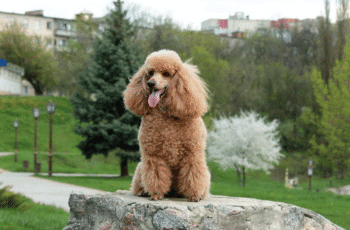TSA lines and the whole full-body scanner thing aside, flying is a great way to get outta town. Whether you’re planning an extended excursion or simply a weekend away, you might wanna bring your pup on the plane. Here are our tips for flying with dogs to ensure you and your pooch are ready for takeoff.
Determine: carry-on or cargo? Your first job is to find out where Fido will sit. In addition to general weight and size restrictions for carry-on vs. stowed pooches, most airlines have rules about how many pets are allowed on a flight, when and where they can travel, and the type of carrier you can check or bring on board. Familiarize yourself with the regs well in advance of your flight and follow them to a T.
Think twice. If your dog only qualifies for the cargo hold, ask yourself if you really need to fly with your four-legged friend. We mean really. The Humane Society of the United States recommends keeping pets grounded due to the number of injuries, losses, even deaths of dogs placed in commercial cargo holds. If you can drive, do it. If not, consider leaving Rover in the capable hands of a friend, pet sitter, or boarding facility.
Count the cost to you. Airlines charge a pretty penny to transport your pooch from A to B. Factor in the total cost to carry-on or stow Spot before purchasing your ticket to avoid surprises at check-in.
…and to your pet. Don’t discount the emotional trauma some pooches may experience in-flight. We’ve said it before, and we’ll say it again: Know thy dog. If you don’t think your pup is a good candidate for flight, ground him. FYI: The USDA requires pets are at least eight weeks old and fully weaned before flying. Plus air travel can be dangerous for brachycephalic (fancy for “pushed-in” faced) breeds such as Pekingese and bulldogs; their short nasal passages leave ’em vulnerable to oxygen deprivation and heat stroke.
Visit the vet. Make sure all vaccinations are up-to-date, and get a signed certificate of health from your doc well in advance of travel day. (Don’t forget to bring the paperwork to the airport.) If you’re flying internationally, check with the destination country about any additional health considerations.
Kennel up. Carry-on pets require a kennel that fits under the airline seat. Cargo-bound canines need to be able to turn around and lie down comfortably and may require a food and water dish, bedding, and a “Live Animal” sticker. Each airline does it a bit differently, so do your research before booking. Now’s the time to go overboard with labeling: Your name, contact info (home and away), departure locale, and destination should be on both the kennel and your dog’s collar. And carry a current photo of your pet.
Book ’em, Danno. Shorter travel is better travel. If possible, book a direct, non-peak flight. Keep your pooch cool by choosing an early-morning or late-night flight in the summer. Lastly, stay on the same flight as Fido. Airlines often send cargo separate from its humans; ask to watch your pup being loaded into the plane. (And perhaps this goes without saying, but ensure the airline knows you’re bringing your furry friend.)
Do a dry run. Get your dog well-acquainted with his airline-approved kennel. Consider taking a trip to the airport before fly day to familiarize him with the sights, sounds, and smells of air travel. If your pup feels at ease in his new digs and surroundings, the trip is likely to go smoother.
Arrive early. Plan to check in at the ticket counter (pets can’t do curbside) at least two hours prior to boarding. But be aware that airlines will not check in your be-pawed pal more than four hours before your flight.
See also


Feed and water Fido. The USDA requires you offer your pet food and water within four hours of check-in. Keep eating to a minimum at this time; a full stomach for flying is not a good idea.
Don’t drug. As tempting as it may be to slip Sadie a sedative to calm her nerves (or yours?), dogs, flying, and Valium don’t mix. The altitude mixed with medication can put your pet at risk for respiratory or cardiovascular issues in-flight. An out-of-it dog also may be a danger to himself. “An animal’s natural ability to balance and maintain equilibrium is altered under sedation,” says Patricia Olson, DVM, former director of veterinary affairs and studies for the American Humane Association. “When the kennel is moved, a sedated animal may not be able to brace and prevent injury.”
Know where to go. Most major airports offer pet-relief areas. Locate your airport’s go spots before you travel and allow at least an hour to find it, let your pup go, and get back through security.
Respect your seat mates (and befriend the flight attendants). Not all your fellow travelers will be thrilled to see you walk aboard with man’s best friend. Respect your seat mates’ space by keeping your pup pacified and quiet. Ensure the flight attendants know you have a pooch on board and thank them profusely for helping out with your carry-on canine.
Expect the unexpected. Even the best-laid flight plans are at the mercy of delays, security lines, and your pup’s behavior. Go in expecting the best but be prepared for the worst — armed with plenty of toys, treats, comfort items, wipes, and anything else that will make your (and your dog’s) trip smooth sailing.


